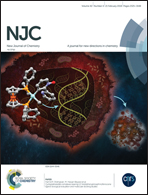Real-time and label-free detection of bisphenol A by an ssDNA aptamer sensor combined with dual polarization interferometry
Abstract
A real-time and label-free strategy for bisphenol A (BPA) detection was developed using an ssDNA aptamer modified sensor combined with dual polarization interferometry (DPI). The BPA-specific aptamer, which played the role of a specific probe for recognizing and binding the target BPA, was immobilized on the surface of a sensor chip through biotin–avidin interactions. Conformational changes on the sensor surface when binding the target were monitored in real time by DPI, so that data on mass, thickness and density were obtained. Our results verified that the developed sensor had good specificity for the target, as the changes in mass, thickness and density induced by BPA were much more significant than those induced by an analogue. It was found that, with the increase of BPA concentration, the mass and thickness on the sensor surface increased while the density decreased. Both mass and thickness changes on the sensor surface showed good linearity with the BPA concentration in the range of 1–20 μM, with correlation coefficients (R2) of 0.9946 and 0.9950, respectively. This work provides a demonstration for the first time that DPI is a reliable and efficient platform for real-time and label-free detection of organic pollutants and toxicants.



 Please wait while we load your content...
Please wait while we load your content...